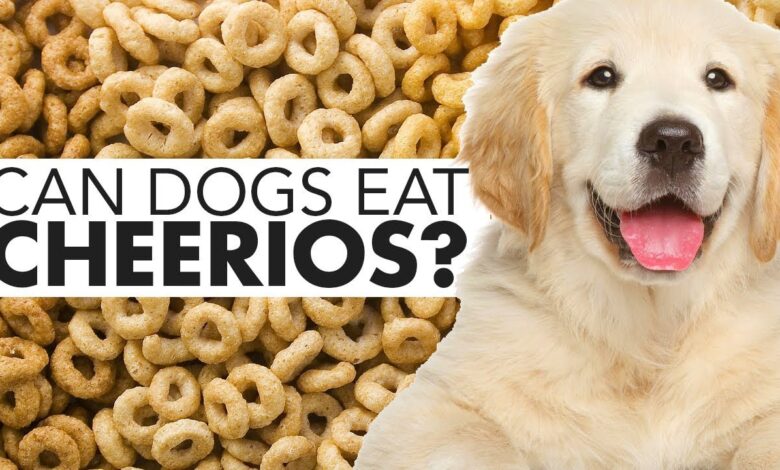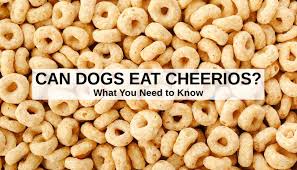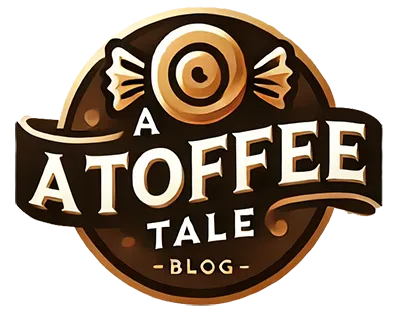Can Dogs Safely Eat Cheerios? Discover the Truth-2024

In recent years, Cheerios have become a subject of interest among pet owners curious about whether this beloved cereal can be safely shared with their canine companions. This article delves into the ingredients and nutritional composition of it, exploring their potential role in dog nutrition and providing crucial insights into their safety.
Cheerios are predominantly made from whole grain oats, a staple known for its high fiber content that supports digestive health. Alongside oats, Cheerios include ingredients such as corn starch, sugar, salt, and a variety of essential vitamins and minerals. Understanding these components is vital for evaluating their nutritional value and potential benefits for dogs.
From a nutritional standpoint, it offers around 100 calories per serving, mainly derived from carbohydrates. They are low in fat and moderate in protein, which aligns with the balanced dietary needs of many humans. However, when considering their suitability for dogs, it’s essential to compare it with typical dog food formulations, which prioritize higher protein content and specific nutrients crucial for canine health.
The purpose of this article is to equip pet owners with a comprehensive understanding of its ingredients and nutritional profile, emphasizing their implications for dog nutrition. Readers can expect to learn about the specific vitamins and minerals present in it, how they compare to dog-specific foods, and guidelines for safely incorporating them into their pets’ diets.
Importantly, this article highlights the importance of safety when feeding it to dogs. While it can offer some nutritional benefits in moderation, pet owners must consider potential allergens, additives, and the overall dietary balance necessary for their dogs’ wellbeing. By providing clarity on these aspects, this article aims to empower pet owners to make informed decisions regarding their pets’ diet and overall health.
While it can be a convenient and potentially beneficial treat for dogs, understanding their ingredients, nutritional content, and safety considerations is crucial. Through this exploration, pet owners can ensure that any treats given to their furry friends contribute positively to their health and happiness.Lets know about that- can dogs eat Cheerios?

Nutritional Breakdown of Cheerios
When evaluating it as a potential treat for dogs, understanding their nutritional breakdown is crucial. This analysis provides insights into their calorie content, carbohydrate levels, fiber content, and comparison with typical dog food and treats, along with an exploration of vitamins, minerals, and other nutrients present in Cheerios.
Nutritional Breakdown of Cheerios
- Calories: Cheerios are relatively low in calories per serving, making them suitable for dogs as an occasional treat.
- Approximately 100 calories per 1 cup serving.
- Carbohydrates: They are primarily composed of carbohydrates, with a lower amount of protein and fat.
- Approximately 20-22 grams of carbohydrates per 1 cup serving.
- Fiber: Cheerios contain dietary fiber, which supports digestive health and can aid in maintaining regular bowel movements.
- Approximately 3 grams of fiber per 1 cup serving.
- Protein and Fat: They provide a moderate amount of protein and are low in fat.
- Approximately 3 grams of protein and 2 grams of fat per 1 cup serving.
- Comparison with Typical Dog Food and Treats
- Caloric Density: Compared to many dog treats, Cheerios are lower in calories, making them a potentially lighter option for treating.
- Carbohydrate Levels: While dogs require a balanced diet with protein as a primary nutrient, moderate carbohydrate levels can complement their nutritional needs.
- Fiber Content: Higher fiber content can support digestion, particularly in dogs prone to digestive issues.
Vitamins, Minerals, and Other Nutrients in Cheerios
- Fortification: Cheerios are often fortified with vitamins and minerals, including:
- Iron: Supports healthy red blood cells and oxygen transport.
- Vitamin D: Important for bone health and immune function.
- B Vitamins (B6, B12, Folate): Essential for energy metabolism and overall health.
- Zinc: Aids in skin health, wound healing, and immune function.
- Considerations for Dogs
- Moderation: While Cheerios offer some nutritional benefits, they should be given in moderation to avoid potential issues like weight gain or digestive upset.
- Individual Needs: Consult with your veterinarian to determine if Cheerios are suitable for your dog based on their specific health conditions, dietary requirements, and overall nutritional balance.
Understanding the nutritional content of it allows pet owners to make informed decisions about incorporating them into their dog’s diet as a treat, ensuring they contribute positively to their pet’s overall health and well-being.
Expert Opinions on the Safety
When considering it as a potential treat for dogs, it’s essential to gather expert opinions to understand their safety, potential choking hazards, digestibility, and any allergies or sensitivities associated with their ingredients. Veterinarians provide valuable insights into these aspects, ensuring responsible treat-giving practices for canine companions.
Veterinarian Perspectives on Feeding Cheerios to Dogs
- Moderation: Veterinarians generally consider it safe when given in moderation as an occasional treat.
- Nutritional Balance: They emphasize the importance of considering it as part of a balanced diet, ensuring they do not replace essential nutrients from regular meals.
- Portion Control: Advises adjusting serving sizes based on the dog’s size and dietary needs to prevent overconsumption.
Consideration of Potential Choking Hazards, Especially for Small Breeds
- Size and Shape: These are small and round, posing a potential choking hazard, particularly for small dog breeds or dogs prone to gulping treats.
- Precautions: Veterinarians recommend breaking it into smaller pieces or choosing softer treats to reduce the risk of choking. Always supervise dogs during treat consumption.
Insights into the Digestibility of Cheerios in Dogs
- Whole Grains: Cheerios primarily consist of whole grain oats, which are generally easy for dogs to digest.
- Fiber Content: The fiber in it can support digestive health by promoting regular bowel movements and overall gut health in dogs.
Discussion on Allergies or Sensitivities Related to Cheerios Ingredients
- Ingredient Check: While these are generally well-tolerated, some dogs may have sensitivities or allergies to ingredients such as wheat or additives.
- Symptoms: Veterinarians advise monitoring for signs of allergic reactions such as itching, skin irritation, digestive upset (vomiting, diarrhea), or changes in behavior after consuming it.
By considering these expert perspectives and guidelines, dog owners can make informed decisions about incorporating it into their dog’s diet responsibly. Always prioritize your dog’s health and well-being by consulting with a veterinarian if you have any concerns or questions regarding treats or dietary choices for your pet.
Benefits of Cheerios for Dogs
It can serve as a beneficial addition to a dog’s diet, offering a low-calorie treat option that incorporates whole grains and supports training efforts, all while being convenient to handle. Here’s a detailed exploration of the benefits of it for dogs:
Low-Calorie Treat Option Suitable for Dogs
- Caloric Content: Cheerios are low in calories compared to many other dog treats, making them suitable for dogs on calorie-controlled diets or those prone to weight gain.
- Portion Control: Allows for frequent treating without excessive caloric intake, promoting a healthy weight balance in dogs.
Benefits of Whole Grains in Dog Digestion and Health
- Digestive Health: Whole grain oats in it provide dietary fiber, which supports healthy digestion and helps regulate bowel movements in dogs.
- Nutrient Absorption: Enhances nutrient absorption and promotes overall gut health, contributing to a well-rounded diet for dogs.
Usefulness in Training and Behavior Reinforcement
- Size and Manageability: Cheerios are small and easy to handle, making them perfect for use during training sessions or as small, frequent rewards.
- Palatability: Dogs often find it palatable, making them effective for positive reinforcement of desired behaviors such as obedience training.
Convenience and Ease of Handling as a Snack
- Portability: Cheerios are lightweight and do not require refrigeration, making them convenient to carry during outings or training sessions.
- Storage: They have a long shelf life and can be stored easily in sealed containers or treat pouches, ensuring freshness and accessibility.
Incorporating it into your dog’s routine can provide these practical benefits while contributing positively to their overall health and well-being. As with any treat, ensure moderation and monitor your dog’s intake to maintain a balanced diet and prevent overfeeding. By leveraging the nutritional advantages and practicality of it, dog owners can enhance their pet’s enjoyment and support their training and dietary needs effectively.
Potential Risks and Concerns
When considering it as a treat option for dogs, it’s important to be aware of potential risks and concerns associated with their consumption. Understanding these factors helps ensure responsible treat-giving practices and maintains the overall health of your canine companion. Here’s an exploration of the potential risks and concerns related to Cheerios for dogs:
High Carbohydrate and Sugar Content in Cheerios
- Nutritional Balance: Cheerios contain carbohydrates and a moderate amount of sugar, which may not align perfectly with a dog’s dietary requirements.
- Blood Sugar Levels: High carbohydrate and sugar content can lead to spikes in blood sugar levels, especially in dogs prone to diabetes or insulin sensitivity.
Risks of Weight Gain and Obesity if Cheerios Are Overfed
- Caloric Consideration: Despite being low in fat, Cheerios contribute to overall calorie intake.
- Portion Control: Overfeeding Cheerios or using them too frequently as treats can disrupt a dog’s caloric balance and contribute to obesity over time.
Impact on Dental Health Due to Sugar Content
- Sugar and Dental Decay: The sugars in Cheerios can adhere to teeth, potentially contributing to dental plaque buildup and dental decay if not managed properly.
- Dental Hygiene: Regular dental care, such as brushing your dog’s teeth or providing dental chews, is crucial when offering Cheerios or similar treats.
Identification of Potential Allergens or Ingredient Sensitivities
- Ingredient Sensitivities: Some dogs may be allergic or sensitive to ingredients in Cheerios, such as wheat or additives.
- Symptoms: Watch for signs of allergies or sensitivities, including itching, skin irritation, digestive upset (e.g., vomiting, diarrhea), or changes in behavior after consuming Cheerios.
By being mindful of these potential risks and concerns, dog owners can make informed decisions about including Cheerios in their pet’s diet. Moderation, portion control, and awareness of your dog’s individual dietary needs are essential to ensure treats contribute positively to their overall health and well-being. Consulting with a veterinarian can provide tailored advice based on your dog’s specific health conditions and nutritional requirements.
Guidelines for Safely Feeding Cheerios to Your Dog
Introducing Cheerios into your dog’s diet can be done safely by following these guidelines to ensure they are given responsibly and monitored for any adverse effects:
Recommended Serving Sizes Based on Dog Size and Breed
- Small Dogs (e.g., Chihuahua, Toy Poodle): Start with 1-2 Cheerios per serving.
- Medium Dogs (e.g., Cocker Spaniel, Beagle): Offer 2-4 Cheerios per serving.
- Large Dogs (e.g., Labrador Retriever, German Shepherd): Provide 4-6 Cheerios per serving.
Adjust serving sizes based on your dog’s weight, activity level, and nutritional needs to prevent overfeeding.
Tips for Introducing Cheerios into Your Dog’s Diet Safely
- Gradual Introduction: Begin by offering a small amount of Cheerios mixed with their regular food or as a standalone treat.
- Observation: Monitor your dog closely for any signs of digestive upset, allergies, or changes in behavior after introducing Cheerios.
- Increase Gradually: If your dog tolerates Cheerios well, gradually increase the amount over several days while continuing to monitor their response.
Frequency of Feeding Cheerios as a Treat or Snack
- Moderation: Use Cheerios as an occasional treat or snack rather than a daily staple to avoid excessive caloric intake and ensure they do not replace essential nutrients from regular meals.
- Training and Rewards: Incorporate Cheerios during training sessions or as small rewards for positive behaviors.
Monitoring Your Dog’s Health and Behavior for Any Adverse Effects
- Immediate Observation: Watch for any adverse reactions such as itching, skin irritation, digestive upset (vomiting, diarrhea), or changes in behavior after consuming Cheerios.
- Consult Your Veterinarian: If you notice persistent or severe reactions, consult your veterinarian promptly to assess if Cheerios are suitable for your dog and how to adjust their diet accordingly.
By following these guidelines, you can safely incorporate Cheerios into your dog’s diet as a treat or occasional snack, ensuring they are given in moderation and tailored to your dog’s specific needs. Always prioritize your dog’s health and adjust their treat intake based on their individual responses to Cheerios or any new food item.




